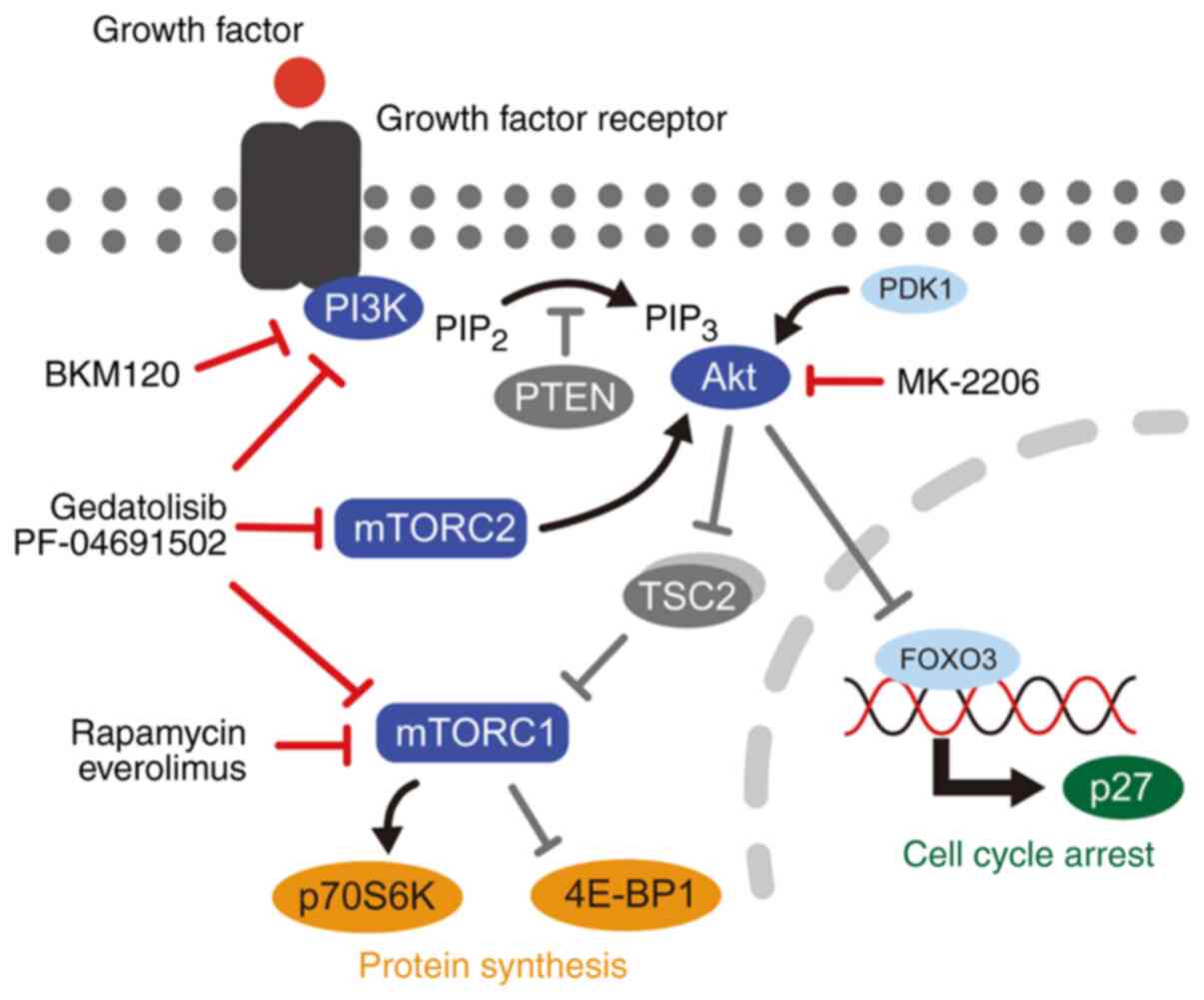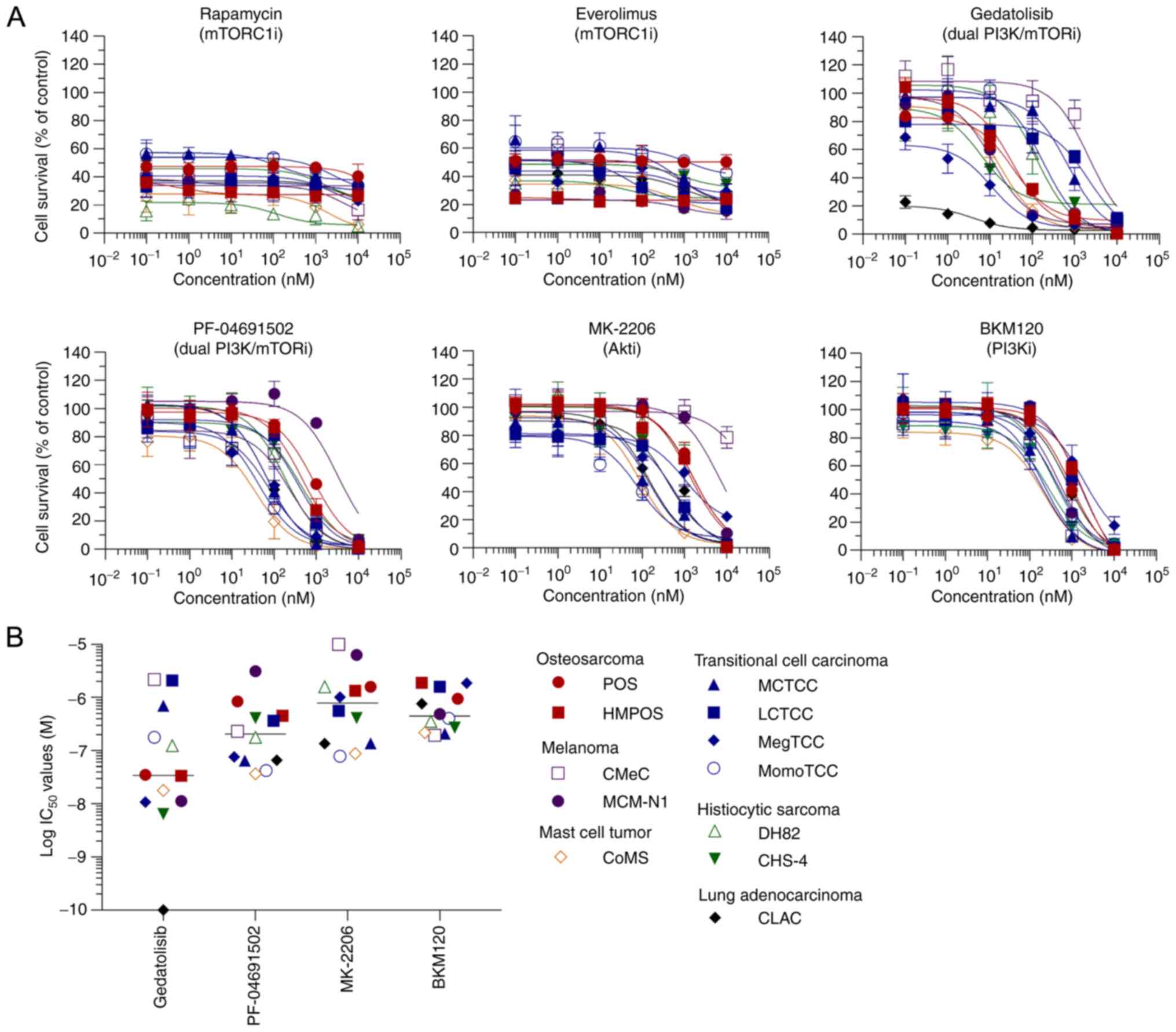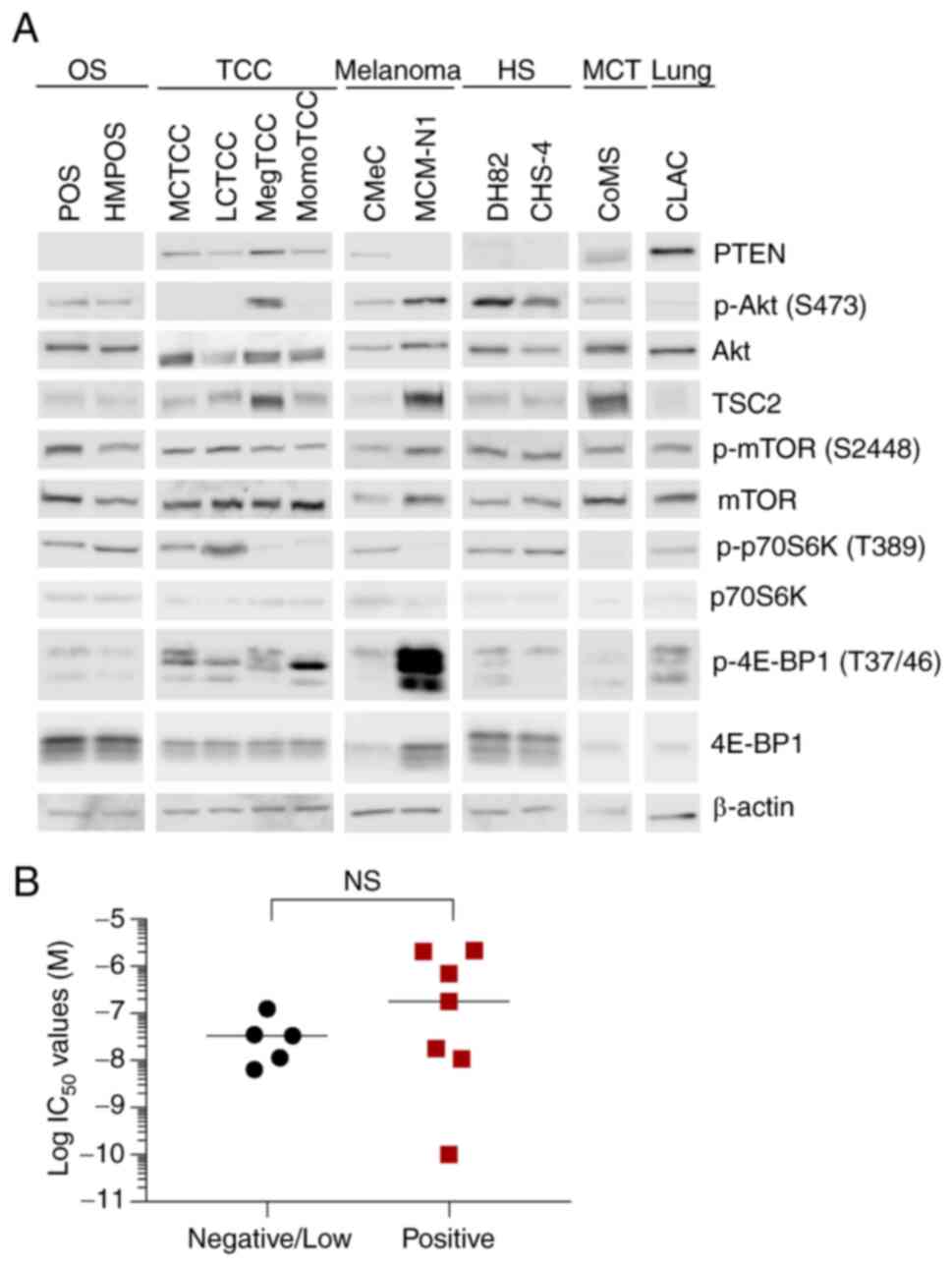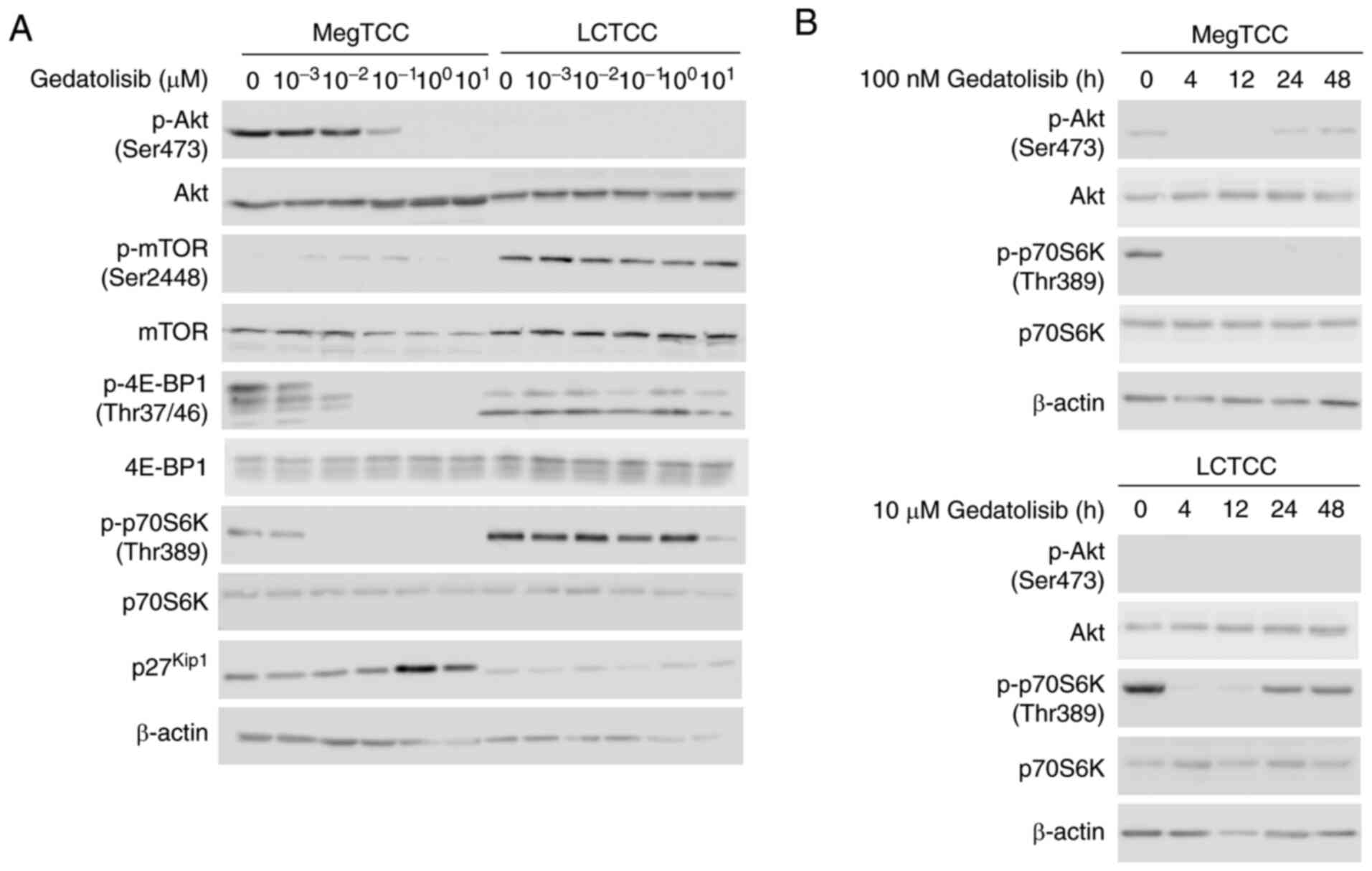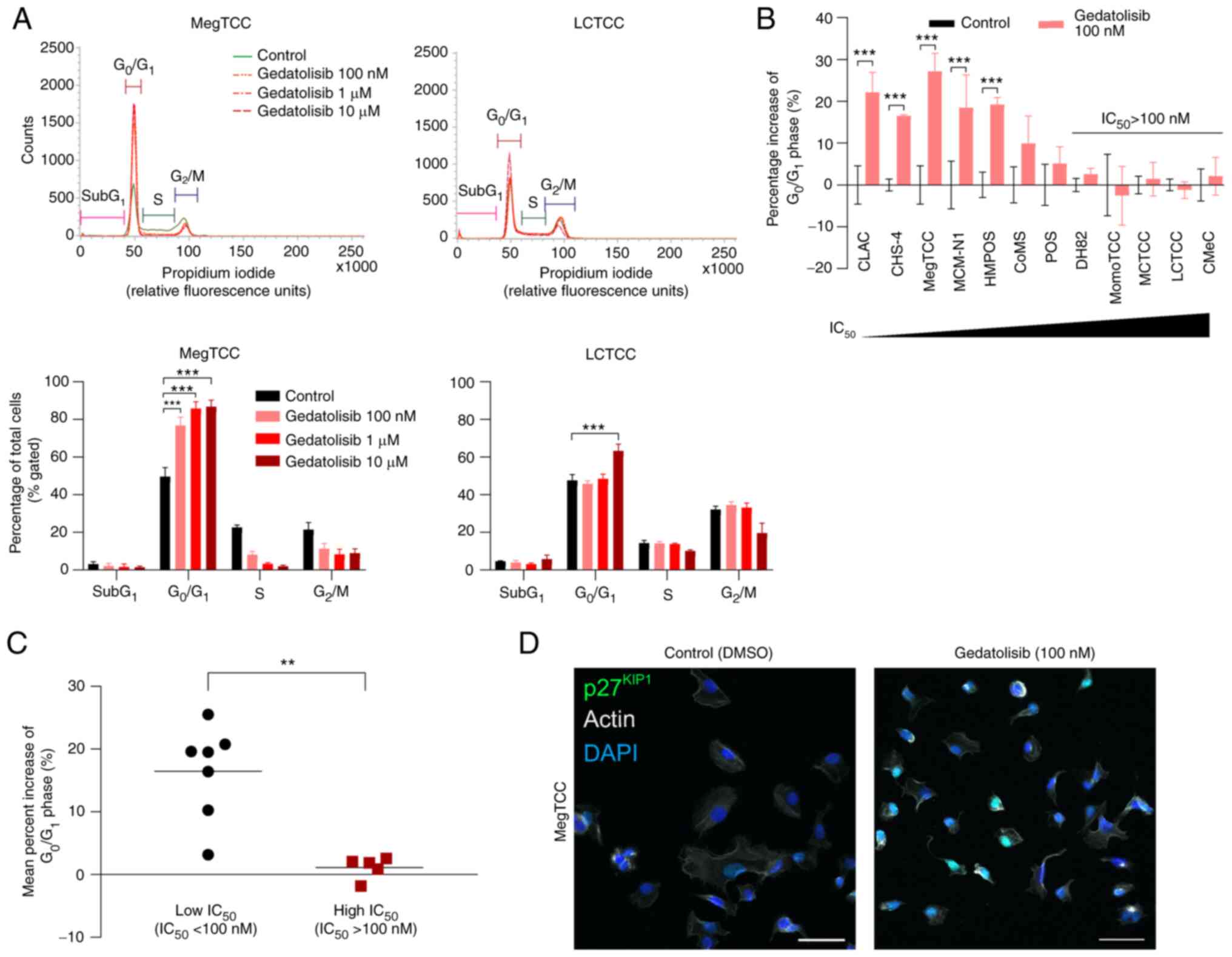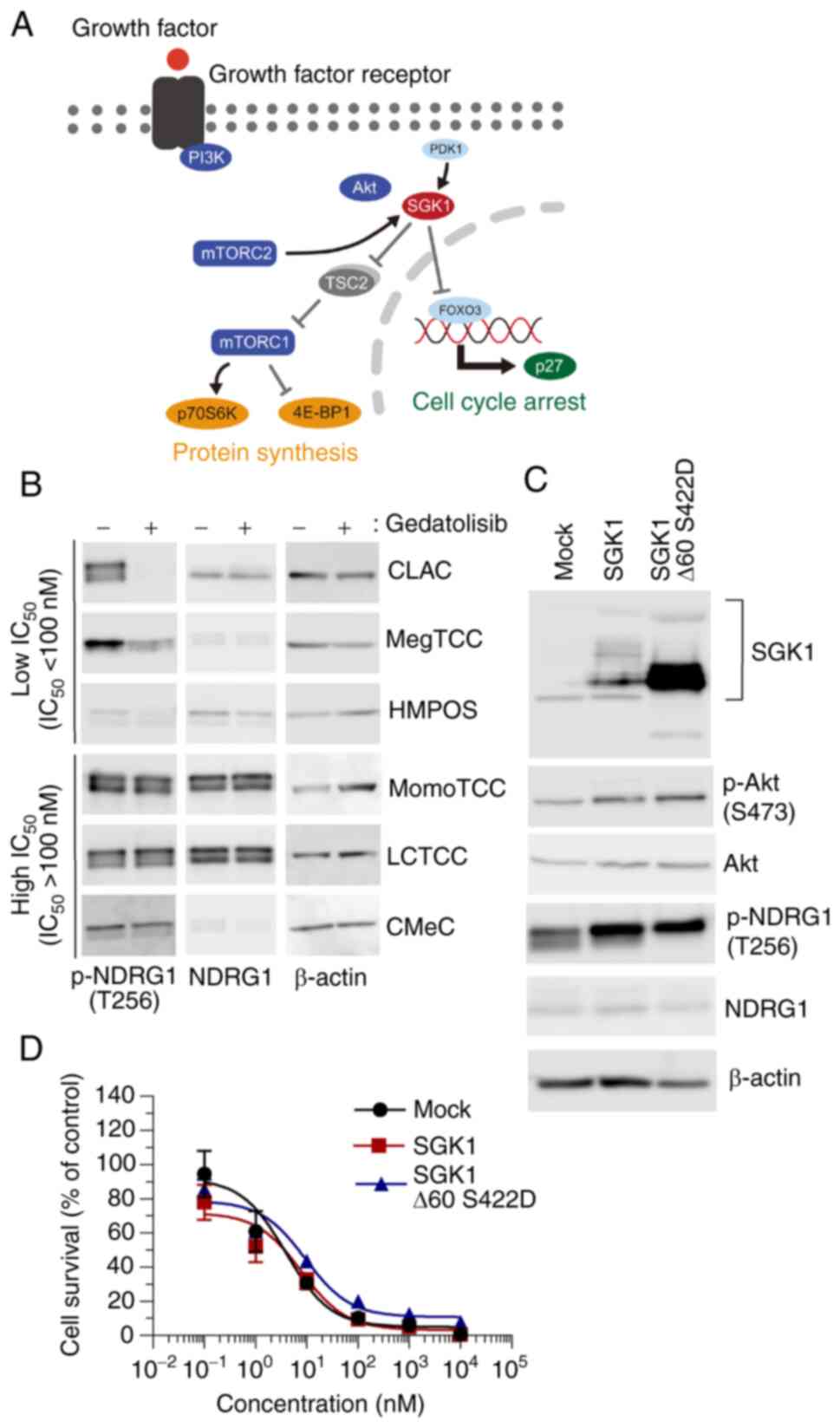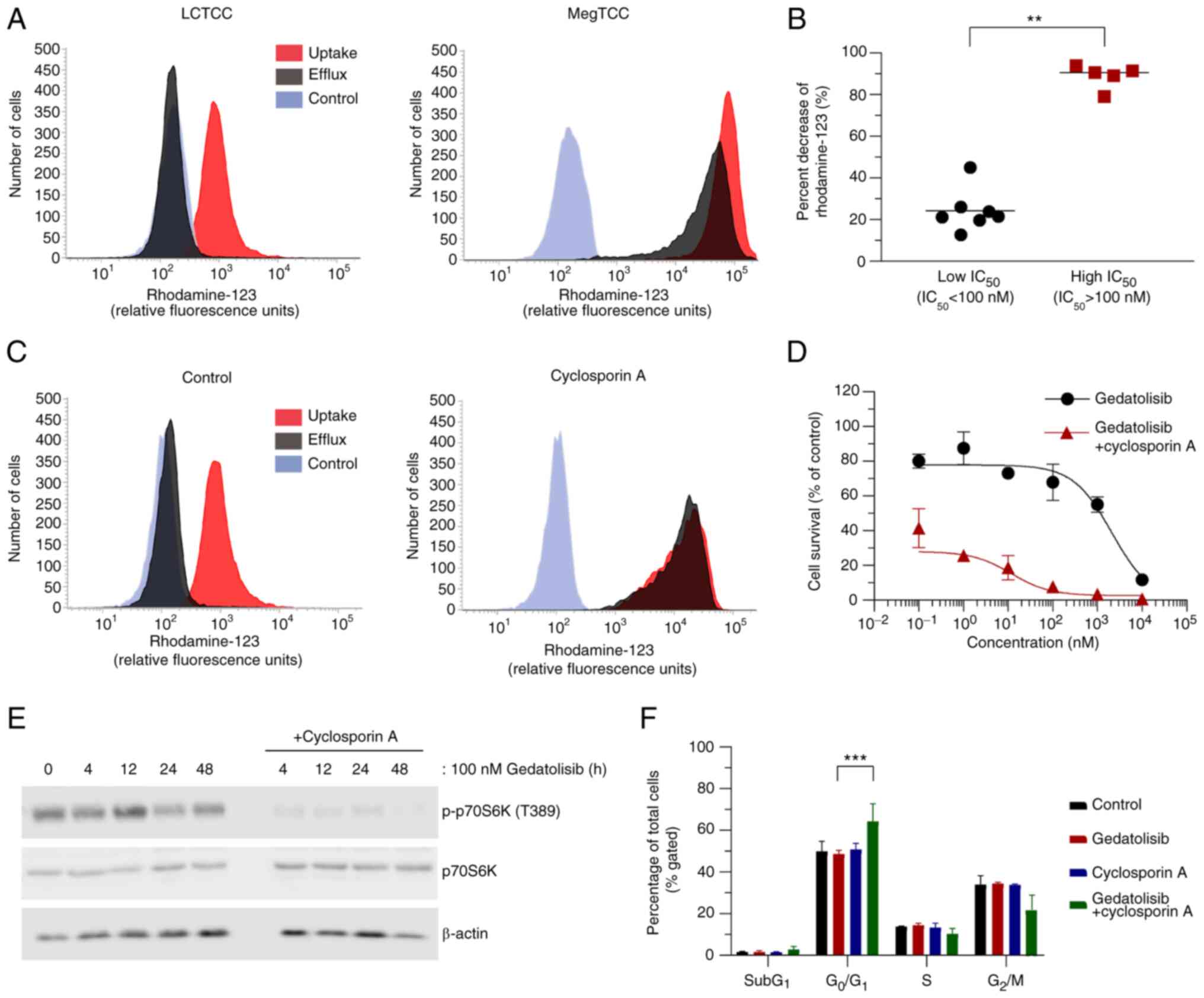|
1
|
Thorpe LM, Yuzugullu H and Zhao JJ: PI3K
in cancer: Divergent roles of isoforms, modes of activation and
therapeutic targeting. Nat Rev Cancer. 15:7–24. 2015. View Article : Google Scholar : PubMed/NCBI
|
|
2
|
Fruman DA and Rommel C: PI3K and cancer:
Lessons, challenges and opportunities. Nat Rev Drug Discov.
13:140–156. 2014. View Article : Google Scholar : PubMed/NCBI
|
|
3
|
Janku F, Yap TA and Meric-Bernstam F:
Targeting the PI3K pathway in cancer: Are we making headway? Nat
Rev Clin Oncol. 15:273–291. 2018. View Article : Google Scholar : PubMed/NCBI
|
|
4
|
Wander SA, Hennessy BT and Slingerland JM:
Next-generation mTOR inhibitors in clinical oncology: How pathway
complexity informs therapeutic strategy. J Clin Invest.
121:1231–1241. 2011. View Article : Google Scholar : PubMed/NCBI
|
|
5
|
Courtney KD, Corcoran RB and Engelman JA:
The PI3K pathway as drug target in human cancer. J Clin Oncol.
28:1075–1083. 2010. View Article : Google Scholar : PubMed/NCBI
|
|
6
|
Weigelt B and Downward J: Genomic
determinants of P13K pathway inhibitor response in cancer. Front
Oncol. 2:1092012. View Article : Google Scholar : PubMed/NCBI
|
|
7
|
Serra V, Scaltriti M, Prudkin L, Eichhorn
PJA, Ibrahim YH, Chandarlapaty S, Markman B, Rodriguez O, Guzman M,
Rodriguez S, et al: PI3K inhibition results in enhanced HER
signaling and acquired ERK dependency in HER2-overexpressing breast
cancer. Oncogene. 30:2547–2557. 2011. View Article : Google Scholar : PubMed/NCBI
|
|
8
|
Britschgi A, Andraos R, Brinkhaus H,
Klebba I, Romanet V, Muller U, Murakami M, Radimerski T and
Bentires-Alj M: JAK2/STAT5 inhibition circumvents resistance to
PI3K/mTOR blockade: A rationale for cotargeting these pathways in
metastatic breast cancer. Cancer Cell. 22:796–811. 2012. View Article : Google Scholar : PubMed/NCBI
|
|
9
|
Heavey S, Dowling P, Moore G, Barr MP,
Kelly N, Maher SG, Cuffe S, Finn SP, O'Byrne KJ and Gately K:
Development and characterisation of a panel of
phosphatidylinositide 3-kinase-mammalian target of rapamycin
inhibitor resistant lung cancer cell lines. Sci Rep. 8:16522018.
View Article : Google Scholar : PubMed/NCBI
|
|
10
|
Mallon R, Feldberg LR, Lucas J, Chaudhary
I, Dehnhardt C, Santos ED, Chen Z, dos Santos O, Ayral-Kaloustian
S, Venkatesan A and Hollander I: Antitumor efficacy of PKI-587, a
highly potent dual PI3K/mTOR kinase inhibitor. Clin Cancer Res.
17:3193–3203. 2011. View Article : Google Scholar : PubMed/NCBI
|
|
11
|
Murai A, Abou Asa S, Kodama A, Hirata A,
Yanai T and Sakai H: Constitutive phosphorylation of the
mTORC2/Akt/4E-BP1 pathway in newly derived canine hemangiosarcoma
cell lines. BMC Vet Res. 8:1282012. View Article : Google Scholar : PubMed/NCBI
|
|
12
|
Chen YT, Tan KA, Pang LY and Argyle DJ:
The class I PI3K/Akt pathway is critical for cancer cell survival
in dogs and offers an opportunity for therapeutic intervention. BMC
Vet Res. 8:732012. View Article : Google Scholar : PubMed/NCBI
|
|
13
|
Delgado L, Gärtner E and Pereira PD:
Activation of mammalian target of rapamycin in canine mammary
carcinomas: An immunohistochemical study. J Comp Pathol.
152:138–144. 2015. View Article : Google Scholar : PubMed/NCBI
|
|
14
|
Rodriguez S, Fadlalla K, Graham T, Tameru
B, Fermin CD and Samuel T: Immunohistochemical evaluation of AKT
protein activation in canine mast cell tumours. J Comp Pathol.
147:171–176. 2012. View Article : Google Scholar : PubMed/NCBI
|
|
15
|
Gordon IK, Ye F and Kent MS: Evaluation of
the mammalian target of rapamycin pathway and the effect of
rapamycin on target expression and cellular proliferation in
osteosarcoma cells from dogs. Am J Vet Res. 69:1079–1084. 2008.
View Article : Google Scholar : PubMed/NCBI
|
|
16
|
Paoloni MC, Mazcko C, Fox E, Fan T, Lana
S, Kisseberth W, Vail DM, Nuckolls K, Osborne T, Yalkowsy S, et al:
Rapamycin pharmacokinetic and pharmacodynamic relationships in
osteosarcoma: A comparative oncology study in dogs. PLoS One.
5:e110132010. View Article : Google Scholar : PubMed/NCBI
|
|
17
|
Kent MS, Collins CJ and Ye F: Activation
of the AKT and mammalian target of rapamycin pathways and the
inhibitory effects of rapamycin on those pathways in canine
malignant melanoma cell lines. Am J Vet Res. 70:263–269. 2009.
View Article : Google Scholar : PubMed/NCBI
|
|
18
|
Fowles JS, Denton CL and Gustafson DL:
Comparative analysis of MAPK and PI3K/AKT pathway activation and
inhibition in human and canine melanoma. Vet Comp Oncol.
13:288–304. 2015. View Article : Google Scholar : PubMed/NCBI
|
|
19
|
Wei BR, Michael HT, Halsey CH, Peer CJ,
Adhikari A, Dwyer JE, Hoover SB, El Meskini R, Kozlov S, Weaver
Ohler Z, et al: Synergistic targeted inhibition of MEK and dual
PI3K/mTOR diminishes viability and inhibits tumor growth of canine
melanoma underscoring its utility as a preclinical model for human
mucosal melanoma. Pigment Cell Melanoma Res. 29:643–655. 2016.
View Article : Google Scholar : PubMed/NCBI
|
|
20
|
Pyuen AA, Meuten T, Rose BJ and Thamm DH:
In vitro effects of PI3K/mTOR inhibition in canine hemangiosarcoma.
PLoS One. 13:e02006342018. View Article : Google Scholar : PubMed/NCBI
|
|
21
|
Kadosawa T, Nozaki K, Sasaki N and
Takeuchi A: Establishment and characterization of a new cell line
from a canine osteosarcoma. J Vet Med Sci. 56:1167–1169. 1994.
View Article : Google Scholar : PubMed/NCBI
|
|
22
|
Barroga EF, Kadosawa T, Okumura M and
Fujinaga T: Establishment and characterization of the growth and
pulmonary metastasis of a highly lung metastasizing cell line from
canine osteosarcoma in nude mice. J Vet Med Sci. 61:361–367. 1999.
View Article : Google Scholar : PubMed/NCBI
|
|
23
|
Yamazaki H, Iwano T, Otsuka S, Kagawa Y,
Hoshino Y, Hosoya K, Okumura M and Takagi S: SiRNA knockdown of the
DEK nuclear protein mRNA enhances apoptosis and chemosensitivity of
canine transitional cell carcinoma cells. Vet J. 204:60–65. 2015.
View Article : Google Scholar : PubMed/NCBI
|
|
24
|
Takagi S, Kitamura T, Hosaka Y, Ohsaki T,
Bosnakovski D, Kadosawa T, Okumura M and Fujinaga T: Molecular
cloning of canine membrane-anchored inhibitor of matrix
metalloproteinase, RECK. J Vet Med Sci. 67:385–391. 2005.
View Article : Google Scholar : PubMed/NCBI
|
|
25
|
Inoue K, Ohashi E, Kadosawa T, Hong SH,
Matsunaga S, Mochizuki M, Nishimura R and Sasaki N: Establishment
and characterization of four canine melanoma cell lines. J Vet Med
Sci. 66:1437–1440. 2004. View Article : Google Scholar : PubMed/NCBI
|
|
26
|
Ohashi E, Inoue K, Kagechika H, Hong SH,
Nakagawa T, Takahashi T, Mochizuki M, Nishimura R and Sasaki N:
Effect of natural and synthetic retinoids on the proliferation and
differentiation of three canine melanoma cell lines. J Vet Med Sci.
64:169–172. 2002. View Article : Google Scholar : PubMed/NCBI
|
|
27
|
Wellman ML, Krakowka S, Jacobs RM and
Kociba GJ: A macrophage-monocyte cell line from a dog with
malignant histiocytosis. In Vitro Cell Dev Biol. 24:223–229. 1988.
View Article : Google Scholar : PubMed/NCBI
|
|
28
|
Azakami D, Bonkobara M, Washizu T, Iida A,
Kondo M, Kato R, Niikura Y, Iwaki S, Tamahara S, Matsuki N and Ono
K: Establishment and biological characterization of canine
histiocytic sarcoma cell lines. J Vet Med Sci. 68:1343–1346. 2006.
View Article : Google Scholar : PubMed/NCBI
|
|
29
|
Ishiguro T, Kadosawa T, Mori K, Takagi S,
Okumura M and Fujinaga T: Establishment and characterization of a
new canine mast cell tumor cell line. J Vet Med Sci. 63:1031–1034.
2001. View Article : Google Scholar : PubMed/NCBI
|
|
30
|
Nemoto Y, Maruo T, Sato T, Deguchi T, Ito
T, Sugiyama H, Ishikawa T, Madarame H, Watanabe T, Shida T and
Sahara H: Identification of cancer stem cells derived from a canine
lung adenocarcinoma cell line. Vet Pathol. 48:1029–1034. 2011.
View Article : Google Scholar : PubMed/NCBI
|
|
31
|
Murase Y, Konnai S, Yamada S, Githaka N,
Isezaki M, Ito T, Takano A, Ando S, Kawabata H, Murata S and Ohashi
K: An investigation of binding ability of Ixodes persulcatus
Schulze Salp15 with Lyme disease spirochetes. Insect Biochem Mol
Biol. 60:59–67. 2015. View Article : Google Scholar : PubMed/NCBI
|
|
32
|
Yamada S, Konnai S, Imamura S, Ito T,
Onuma M and Ohashi K: Cloning and characterization of Rhipicephalus
appendiculatus voraxin alpha and its effect as anti-tick vaccine.
Vaccine. 27:5989–5997. 2009. View Article : Google Scholar : PubMed/NCBI
|
|
33
|
Yamasaki T, Suzuki A, Shimizu T, Watarai
M, Hasebe R and Horiuchi M: Characterization of intracellular
localization of PrP(Sc) in prion-infected cells using a mAb that
recognizes the region consisting of aa 119–127 of mouse PrP. J Gen
Virol. 93:668–680. 2012. View Article : Google Scholar : PubMed/NCBI
|
|
34
|
Talarico C, Dattilo V, D'Antona L, Menniti
M, Bianco C, Ortuso F, Alcaro S, Schenone S, Perrotti N and Amato
R: SGK1, the new player in the game of resistance: Chemo-radio
molecular target and strategy for inhibition. Cell Physiol Biochem.
39:1863–1876. 2016. View Article : Google Scholar : PubMed/NCBI
|
|
35
|
Park J, Leong MLL, Buse P, Maiyar AC,
Firestone GL and Hemmings BA: Serum and glucocorticoid-inducible
kinase (SGK) is a target of the PI 3-kinase-stimulated signaling
pathway. EMBO J. 18:3024–3033. 1999. View Article : Google Scholar : PubMed/NCBI
|
|
36
|
García-Martínez JM and Alessi DR: mTOR
complex 2 (mTORC2) controls hydrophobic motif phosphorylation and
activation of serum- and glucocorticoid-induced protein kinase 1
(SGK1). Biochem J. 416:375–385. 2008. View Article : Google Scholar : PubMed/NCBI
|
|
37
|
Thompson JD, Higgins DG and Gibson TJ:
CLUSTAL-W: Improving the sensitivity of progressive multiple
sequence alignment through sequence weighting, position-specific
gap penalties and weight matrix choice. Nucleic Acids Res.
22:4673–4680. 1994. View Article : Google Scholar : PubMed/NCBI
|
|
38
|
Santiskulvong C, Konecny GE, Fekete M,
Chen KYM, Karam A, Mulholland D, Eng C, Wu H, Song M and Dorigo O:
Dual targeting of phosphoinositide 3-kinase and mammalian target of
rapamycin using NVP-BEZ235 as a novel therapeutic approach in human
ovarian carcinoma. Clin Cancer Res. 17:2373–2384. 2011. View Article : Google Scholar : PubMed/NCBI
|
|
39
|
Huynh H, Hao HX, Chan SL, Chen D, Ong R,
Soo KC, Pochanard P, Yang D, Ruddy D, Liu M, et al: Loss of
Tuberous Sclerosis Complex 2 (TSC2) is frequent in hepatocellular
carcinoma and predicts response to mTORC1 inhibitor everolimus. Mol
Cancer Ther. 14:1224–1235. 2015. View Article : Google Scholar : PubMed/NCBI
|
|
40
|
Castel P, Ellis H, Bago R, Toska E, Razavi
P, Carmona FJ, Kannan S, Verma CS, Dickler M, Chandarlapaty S, et
al: PDK1-SGK1 signaling sustains AKT-independent mTORC1 activation
and confers resistance to PI3Kα inhibition. Cancer Cell.
30:229–242. 2016. View Article : Google Scholar : PubMed/NCBI
|
|
41
|
Sommer EM, Dry H, Cross D, Guichard S,
Davies BR and Alessi DR: Elevated SGK1 predicts resistance of
breast cancer cells to Akt inhibitors. Biochem J. 452:499–508.
2013. View Article : Google Scholar : PubMed/NCBI
|
|
42
|
Lee JS, Paull K, Alvarez M, Hose C, Monks
A, Grever M, Fojo AT and Bates SE: Rhodamine efflux patterns
predict P-glycoprotein substrates in the National-Cancer-Institute
drug screen. Mol. Pharmacol. 46:627–638. 1994.PubMed/NCBI
|
|
43
|
Kathawala RJ, Gupta P, Ashby CR and Chen
ZS: The modulation of ABC transporter-mediated multidrug resistance
in cancer: A review of the past decade. Drug Resist Update.
18:1–17. 2015. View Article : Google Scholar : PubMed/NCBI
|
|
44
|
Fox E and Bates SE: Tariquidar (XR9576): A
P-glycoprotein drug efflux pump inhibitor. Expert Rev Anticancer
Ther. 7:447–459. 2007. View Article : Google Scholar : PubMed/NCBI
|
|
45
|
London CA, Hannah AL, Zadovoskaya R, Chien
MB, Kollias-Baker C, Rosenberg M, Downing S, Post G, Boucher J,
Shenoy N, et al: Phase I dose-escalating study of SU11654, a small
molecule receptor tyrosine kinase inhibitor, in dogs with
spontaneous malignancies. Clin Cancer Res. 9:2755–2768.
2003.PubMed/NCBI
|
|
46
|
London CA: Small molecule inhibitors in
veterinary oncology practice. Vet Clin North Am Small Anim Pract.
44:893–908. 2014. View Article : Google Scholar : PubMed/NCBI
|
|
47
|
Shukla S, Robey RW, Bates SE and Ambudkar
SV: Sunitinib (Sutent, SU11248), a small-molecule receptor tyrosine
kinase inhibitor, blocks function of the ATP-binding cassette (ABC)
transporters P-Glycoprotein (ABCB1) and ABCG2. Drug Metab Dispos.
37:359–365. 2009. View Article : Google Scholar : PubMed/NCBI
|
|
48
|
Chapuis N, Tamburini J, Green AS, Vignon
C, Bardet V, Neyret A, Pannetier M, Willems L, Park S, Macone A, et
al: Dual inhibition of PI3K and mTORC1/2 signaling by NVP-BEZ235 as
a new therapeutic strategy for acute myeloid leukemia. Clin Cancer
Res. 16:5424–5435. 2010. View Article : Google Scholar : PubMed/NCBI
|
|
49
|
Mendoza MC, Er EE and Blenis J: The
Ras-ERK and PI3K-mTOR pathways: Cross-talk and compensation. Trends
Biochem Sci. 36:320–328. 2011. View Article : Google Scholar : PubMed/NCBI
|
|
50
|
Lopes-Rodrigues V, Seca H, Sousa D, Sousa
E, Lima RT and Vasconcelos MH: The network of P-glycoprotein and
microRNAs interactions. Int J Cancer. 135:253–263. 2014. View Article : Google Scholar : PubMed/NCBI
|
|
51
|
del Campo JM, Birrer M, Davis C, Fujiwara
K, Gollerkeri A, Gore M, Houk B, Lau S, Poveda A, González-Martín
A, et al: A randomized phase II non-comparative study of
PF-04691502 and gedatolisib (PF-05212384) in patients with
recurrent endometrial cancer. Gynecol Oncol. 142:62–69. 2016.
View Article : Google Scholar : PubMed/NCBI
|
|
52
|
Chen ZL, Shi TL, Zhang L, Zhu PL, Deng MY,
Huang C, Hu TT, Jiang L and Li J: Mammalian drug efflux
transporters of the ATP binding cassette (ABC) family in multidrug
resistance: A review of the past decade. Cancer Lett. 370:153–164.
2016. View Article : Google Scholar : PubMed/NCBI
|















